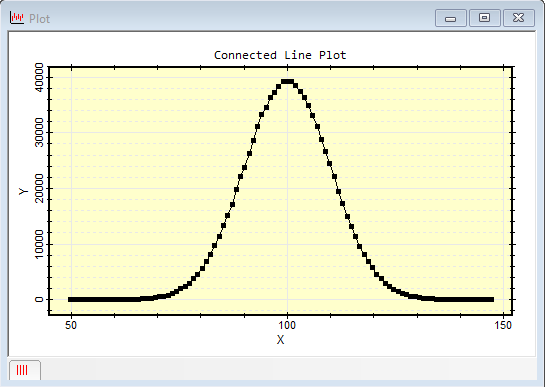
plot (replaces PlotConnected)
The plot function is an older version of the connect function that is retained for compatibility with older scripts. This is an efficient non-class equivalent to the CPlotView:PlotConnected method. It creates a marker plot with lines connecting the markers. The x and y data points come from separate arrays in which the x and y points at the same array index are presumed to define a point. This function also can plot x and y error bars. This function creates a new plot window and returns a CPlotView object and a CPlot object for the plot and the plot series it creates. These objects can be used to enhance or add to the plot or extract plot data for further analysis. There are four similar versions of this command as shown in the Comparison of non-class plotting functions.

CPlotView, CPlot = plot( x, y )
CPlotView, CPlot = plot( x, y, xe )
CPlotView, CPlot = plot( x, y, xe, ye )
CPlotView, CPlot = plot( x, y, xe, ye, sLabelX )
CPlotView, CPlot = plot( x, y, xe, ye, sLabelX, sLabelY )
CPlotView, CPlot = plot( x, y, xe, ye, sLabelX, sLabelY, sCaption )
CPlotView, CPlot = plot( x, y, xe, ye, sLabelX, sLabelY, sCaption, sWindowTitle )
![]() x is a 1-dimensional array containing the x
values.
x is a 1-dimensional array containing the x
values.
![]() y is a 1-dimensional array containing the x
values.
y is a 1-dimensional array containing the x
values.
![]() xe is an optional 1-dimensional array
containing the x error bar values.
xe is an optional 1-dimensional array
containing the x error bar values.
![]() ye is an optional 1-dimensional array
containing the y error bar values.
ye is an optional 1-dimensional array
containing the y error bar values.
![]() sLabelX is an optional label for the x
axis.
sLabelX is an optional label for the x
axis.
![]() sLabelY is an
optional label for the y axis.
sLabelY is an
optional label for the y axis.
![]() sCaption is an optional plot caption.
sCaption is an optional plot caption.
![]() sWindowTitle is an optional plot window
title.
sWindowTitle is an optional plot window
title.
![]() Parameters that are nil or missing to the rightadopt default
values.
Parameters that are nil or missing to the rightadopt default
values.
Return values:
![]() CPlotView
is a new CPlotView object attached to the plot window. It is
nil on failure.
CPlotView
is a new CPlotView object attached to the plot window. It is
nil on failure.
![]() CPlot is a
new CPlot
object attached to the current plot series. It is nil on failure.
CPlot is a
new CPlot
object attached to the current plot series. It is nil on failure.
This function creates a quick but finished plot using just one line of code. The returned values of V and P provide access to the plot window and plotted data. You can also change the plot properties including the marker and line attributes, labels, scaling, and others using commands such as Series Attributes and Plot Attributes.
Only the first 2 arguments, the (x,y) data, need be provided to create the plot. If you want to use the other arguments, you must include a placeholder to fill any holes between Y and the optional arguments.
The script below creates some data from the random number generator and creates a scatter plot with default plot labels. Since none of the optional parameters is used, only the x and y arrays need to be specified.
|
|
-- 10 values between 10 and 20 |
|
|
-- 10 values between 20 and 40 |
|
|
-- create the connected line plot |
The second example, below, repeats the above plot but adds axis labels and error bars on the y axis.
|
|
-- 10 values between 10 and 20 |
|
|
-- 10 values between 20 and 40 |
|
|
-- 10 values between 1 and 3 |
|
|
-- create the connected line plot |
Comparison of non-Class Plotting Functions
Mira Pro x64 Script User's Guide, Copyright Ⓒ 2023 Mirametrics,
Inc. All Rights Reserved.